HOW TO DRAW A FLOOR PLAN TO SCALE
If you have ever wanted to learn how to draw a floor plan then I’ve got you. I will show you just how easy it is to draw your own floor plan and I will give you two ways to do it. If you can use a tape measure and draw some straight lines with a ruler, you can do this!
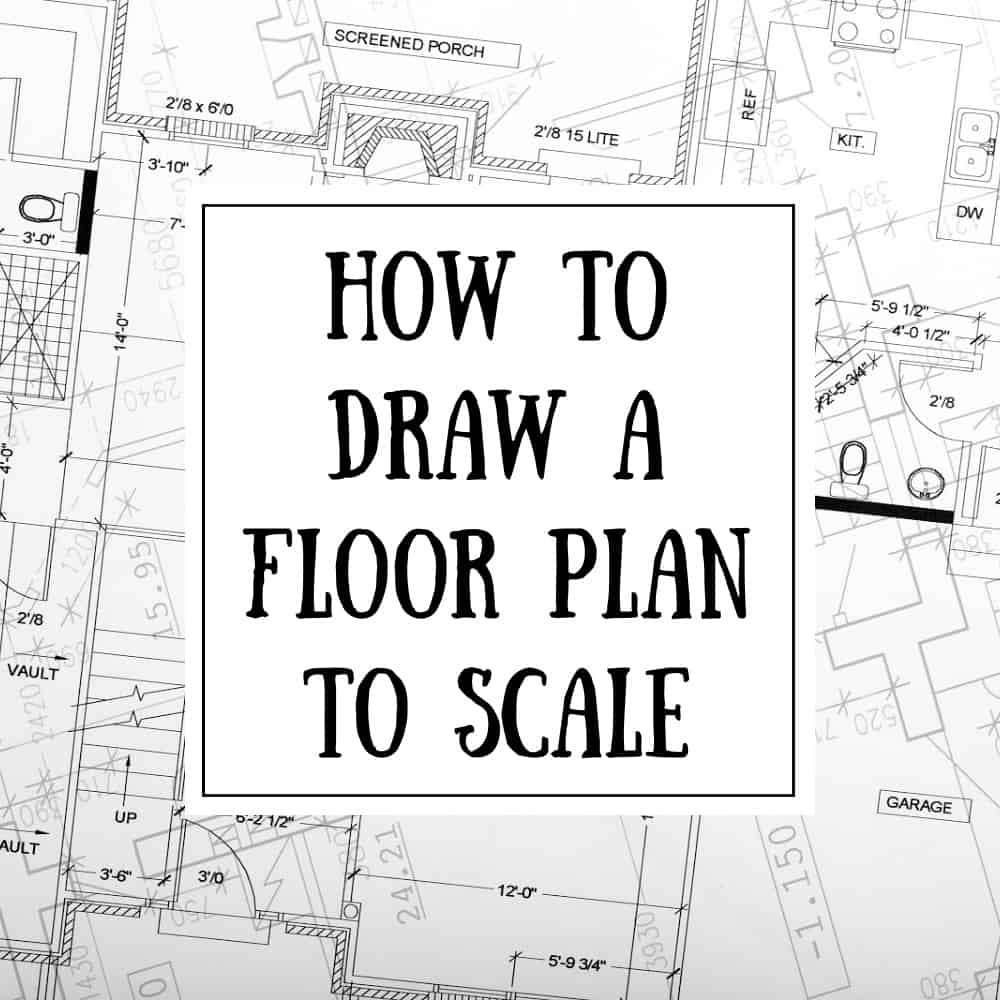
This post may contain affiliate links. If you choose to purchase a recommended product, I may receive a small commission at no additional cost to you. Rest assured that I will not recommend any product that I would not use myself. For our full policies and disclosures click here.
This post is for designing a floor plan for real life. I will teach you how to draw a basic floor plan to scale, and how to make furniture templates, using a rough sketch, some grid paper, and/or plain paper.
You will learn that it’s a good idea to draw a floor plan to ensure you have enough room for the furniture you plan to buy. This is the best way to ensure you don’t waste money on furniture that doesn’t fit in your space.
By the way, this is the same design process that designers would use for space planning if they didn’t have expensive design software and had to use traditional methods.
This post is not for drawing professional floor plans. I will not cover elevation drawings or an elevation view, architectural drawings, new home design, or how to draw house plans in this post.
This is just for building basic floor plans for helping with furniture layout, drawing your room shape, how to draw windows on your floor plan, doors, and other simple structures in your room. If you need precise floor plans then I would contact a designer for help.
Why is drawing a floor plan to scale important?
Drawing a floor plan to scale is important for a few reasons. First, it will save you lots of time and energy. Imagine you want to rearrange the furniture in your room. Normally you would move the furniture around, and around, until you’ve figured out what fits and what looks good. Then after hours of exhausting hard work, you may not even be happy with the results.
Second, it could save you hundreds, or even thousands of dollars. Imagine shopping for a new sectional only to have it delivered weeks later and it doesn’t fit in the room. UGH! Don’t do this. Draw a floor plan first so you don’t make this mistake!
By making your own floor plan to scale you can do the heavy lifting on a piece of paper. Literally, you can move the furniture around on the plan until you have it just the way you want it. You won’t even lift a finger in the room. This will save you hours of trial and error and possibly burning a lot of calories. 😉

You might like this…
For more decorating tips check out my post How to decorate like a pro. I share lots of tips to show you how to get a room just like the designers create.

Note:
I am using my 16 x 20′ living room for an example in this post. However, I will take you step by step to create a floor plan for a room in your home.
Here is a picture of my actual room that I based this scaled drawing on. Use it to reference the examples in the floor plan drawings.

how to draw a floor plan sketch of a room
The first step to start drawing our simple floor plan is to draw a floor plan sketch of the basic shape of your room on a piece of paper. No ruler. Just draw out the four interior walls of your room with a pencil and show the approximation of the doors and windows. We are not going to be dealing with exterior walls because we are just focusing on one room at a time in this post.
This is just for your reference. You will make the actual scaled drawing on another piece of paper later.
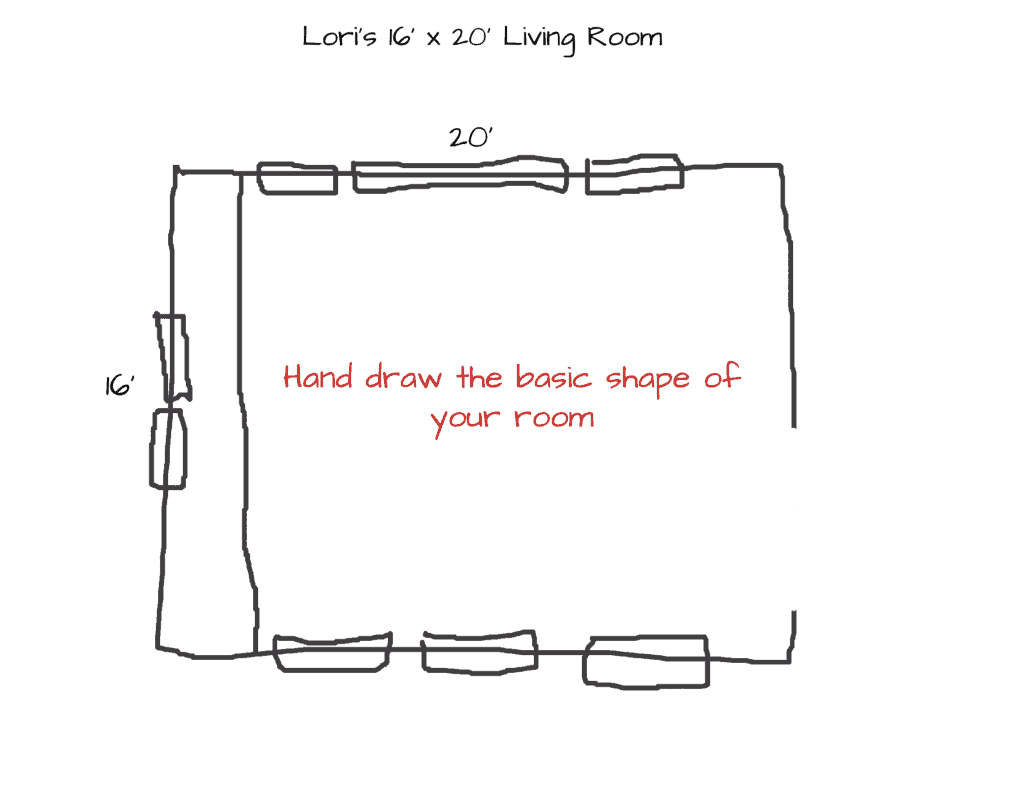
How to measure your room
The easiest way to sketch your floor plan with measurements is to use a tape measure to measure the actual wall from one end to the other. Record the measurements on your drawing in feet and inches.

Start at the beginning of a the longest wall and measure the width of the room. Measure the distance from there to the beginning of a door, window, or other permanent structure. Mark that measurement on your plan. See image below.
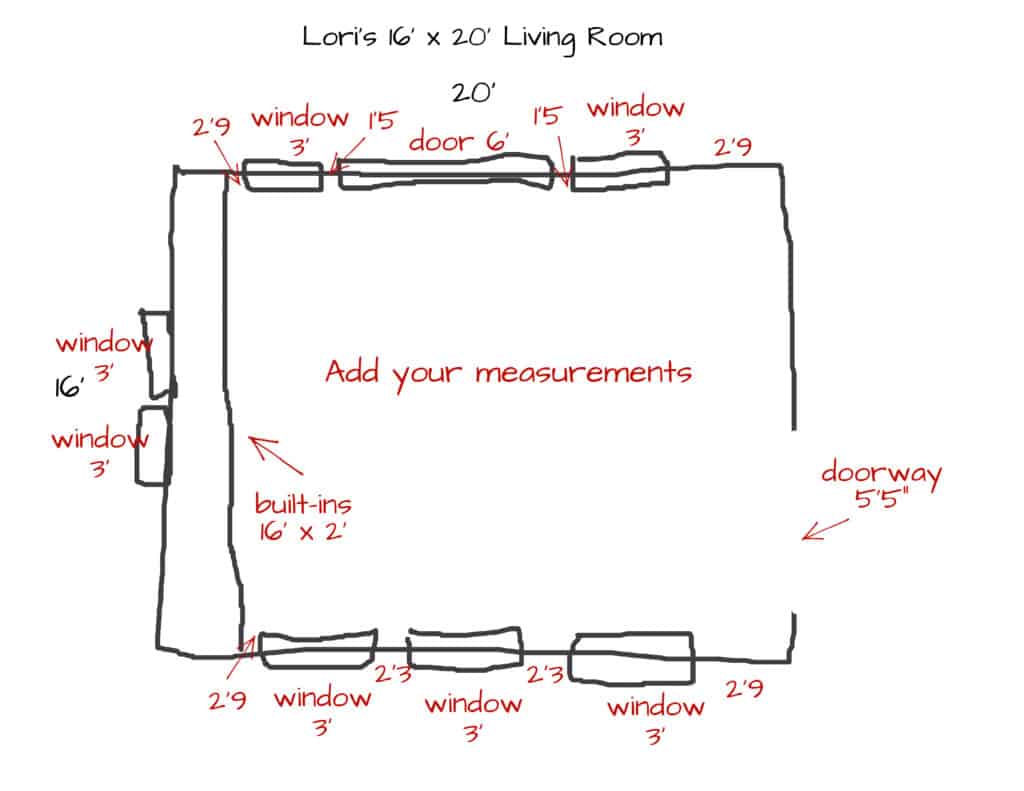
Measure the next item on the wall, mark it on the plan, and continue measuring and marking everything all the way across the wall.
Use a parallel lines with small perpendicular marks to show what the measurement represents. Do this for all of your walls.
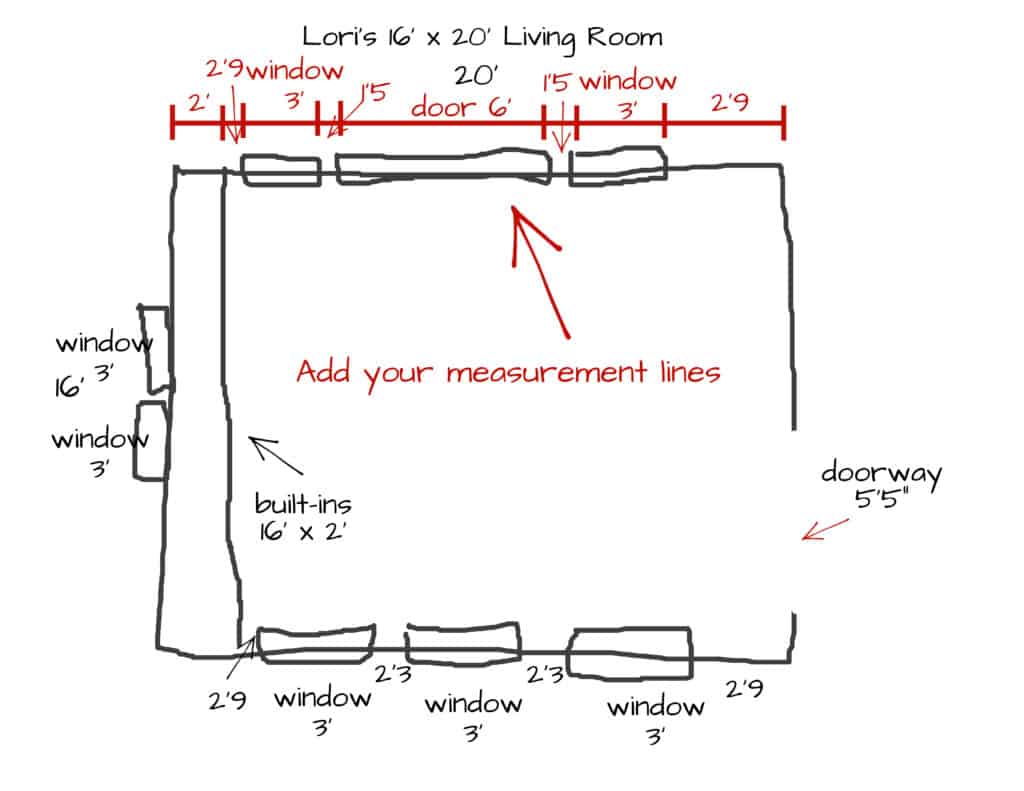
Next, we will take this drawing and measurements and scale them using a piece of graph paper.
How to draw a floor plan to scale using a piece of graph paper
The easiest way to make a scaled drawing plan is by using graph paper. To use this method you are basically counting squares as feet. For example, if your wall was 12′ 6″ (twelve feet, six inches) your line would be 12 1/2 squares long.
Your windows would convert from 3′ (feet) to 3 squares. A fireplace could go from 5′ (feet) to 5 squares and so on.
One thing to keep in mind with making a scaled drawing with graph paper; If your room is small, your scaled drawing will be small too. You can fix this problem one of two ways.
1. Enlarge your floor plan drawing using 2 squares per foot. This will double your plan.
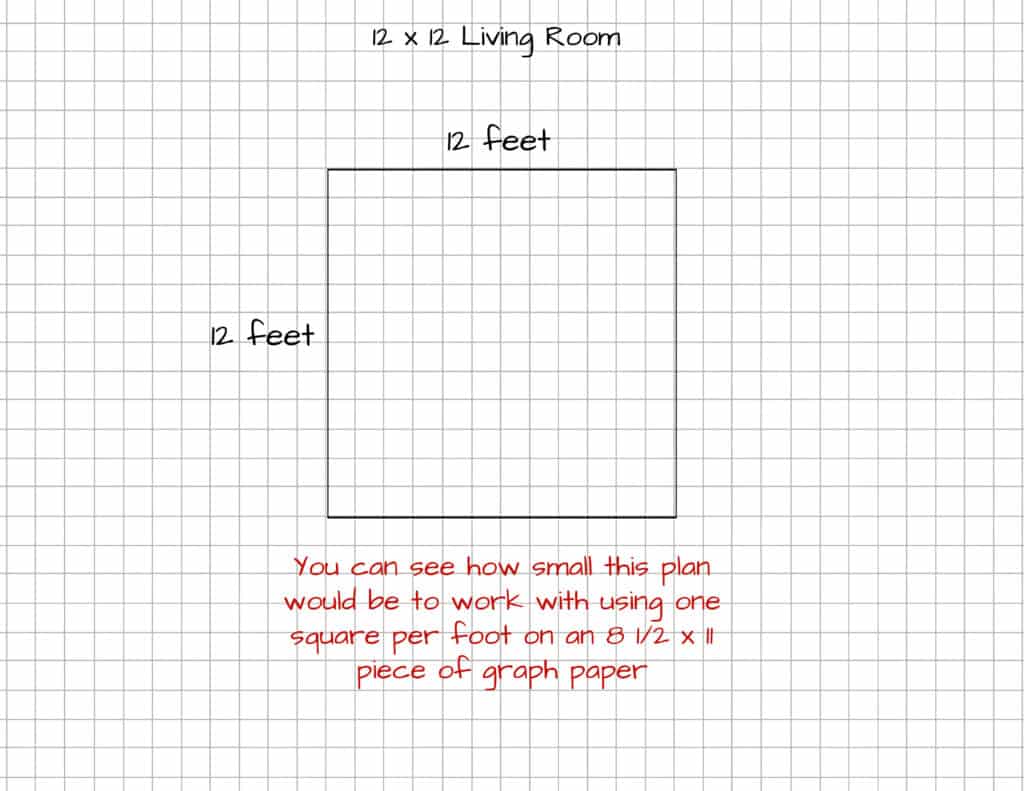
Above: You can see that trying to move virtual furniture around on this piece of paper would be hard to do because the room size is so small.
To fix this, draw your 12 x 12 room using two squares per foot. Now you can see the room plan takes up most of the 8 1/2 x 11″ paper. This will be much easier to use.
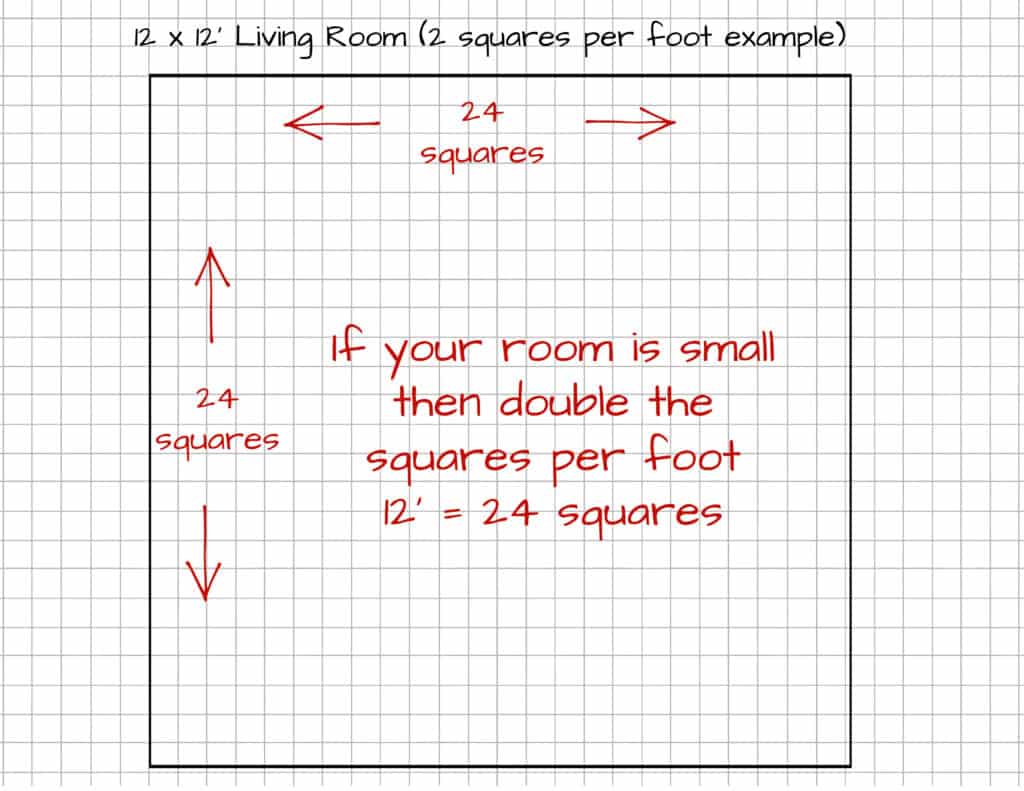
Remember, if you double your room plan you will also have to double all the elements going into the room as well. Doors, windows, furniture, everything.
2. Enlarge your floor plan using a printer.
BUT…if you do this you will also have to enlarge everything you draw for the plan, like furniture, at the same percentage. THIS IS VERY IMPORTANT!
You would just draw your plan with the 1′ = 1 square method and then enlarge the plan with your printer. Remember the percentage you used to enlarge the plan, then enlarge your furniture plan the same way. (More below)
Get a printable PDF version of this post!
Comes complete with a printable furniture template and grid sheet for just $10
How to transfer your hand drawing with measurements to the graph paper.
In the image below I am showing you how I drew my 16′ x 20′ living room. You are going to take your hand drawing and transfer feet into squares.
Start by drawing the outline of the room using solid lines. (Represented below by the black square.) 16 feet = 16 squares, 20 feet = 20 squares.
Now you are going to add your whole room measurement. (Represented by the red line with the room measurement in between.)
Leave room between the wall (the solid line) and the wall measurement, because we are going to be adding the measurements for the doors and windows in between them a bit later.
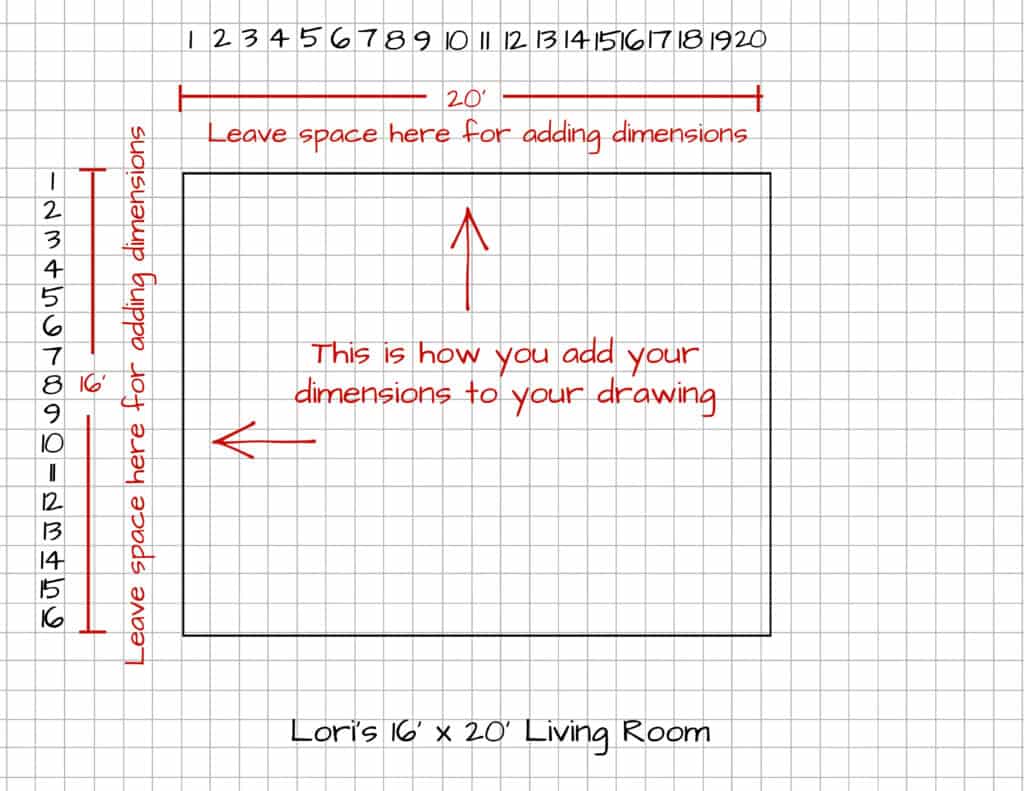
The black numbers are just showing you how I counted the squares 20 squares = 20 feet. You will not be writing these numbers on your paper.
If you have a room that is not a rectangle or square, but instead has bump outs or angled walls, you will need to draw it on the paper just like it is in the room.
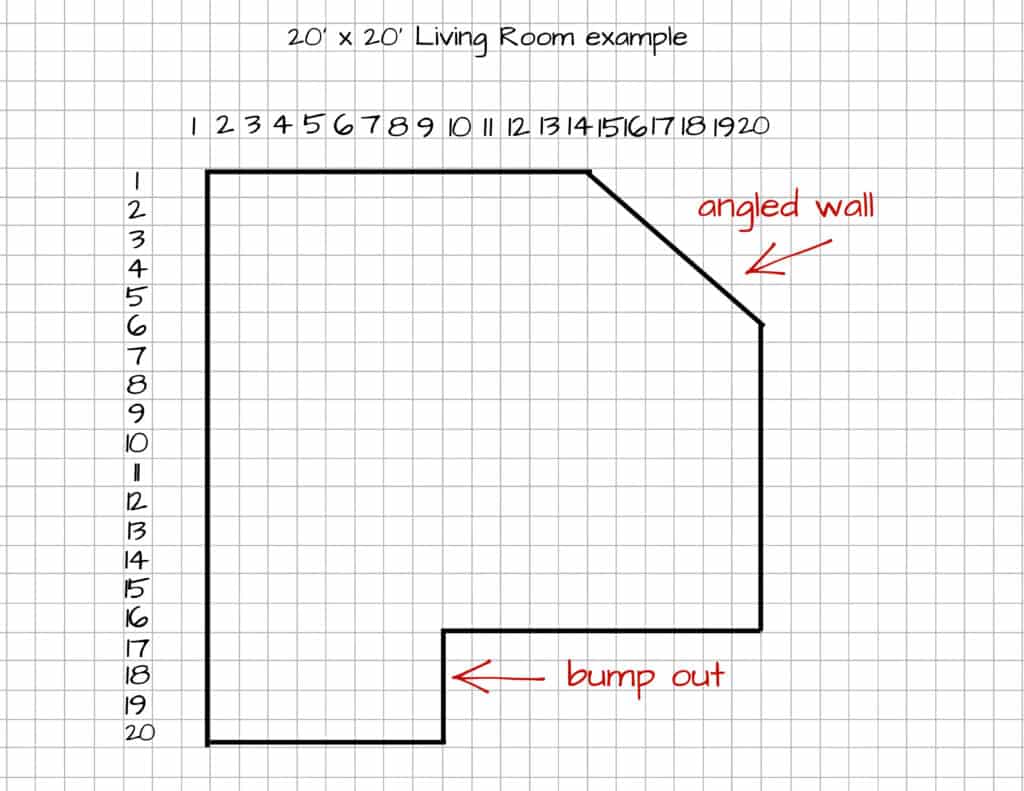
How to draw doors, windows, and other permenant structures on a floor plan
Now your going to draw in anything else that is permanent in the room. Permanent structures could be doors, windows, a fireplace, built-in cabinetry, stairs, or any other structure that can’t be moved and could affect the layout of your furniture. See how to draw them in the next step or you could use a drafting template.
Make sure your template is the same scale you are using to draw your plan. It should be (Scale: 1/4 Inch = 1 Ft) which is what a typical graph paper is. Don’t worry this measurement is just the size of the squares. It will not effect how you transfer your measurements. Just make sure the graph paper you are using is the same scale as the template you purchase.
You will use your hand drawing to transfer your actual measurements onto the graph paper using 1 square per 1 foot or (2 squares per 1 foot if your room is small.)
After writing in the measurements, use a straight edge to make parallel lines and perpendicular marks, also called dimension lines, to show where you are starting and stopping your measurements.
I’ll teach you how to make them look like actual doors and windows in the next section.
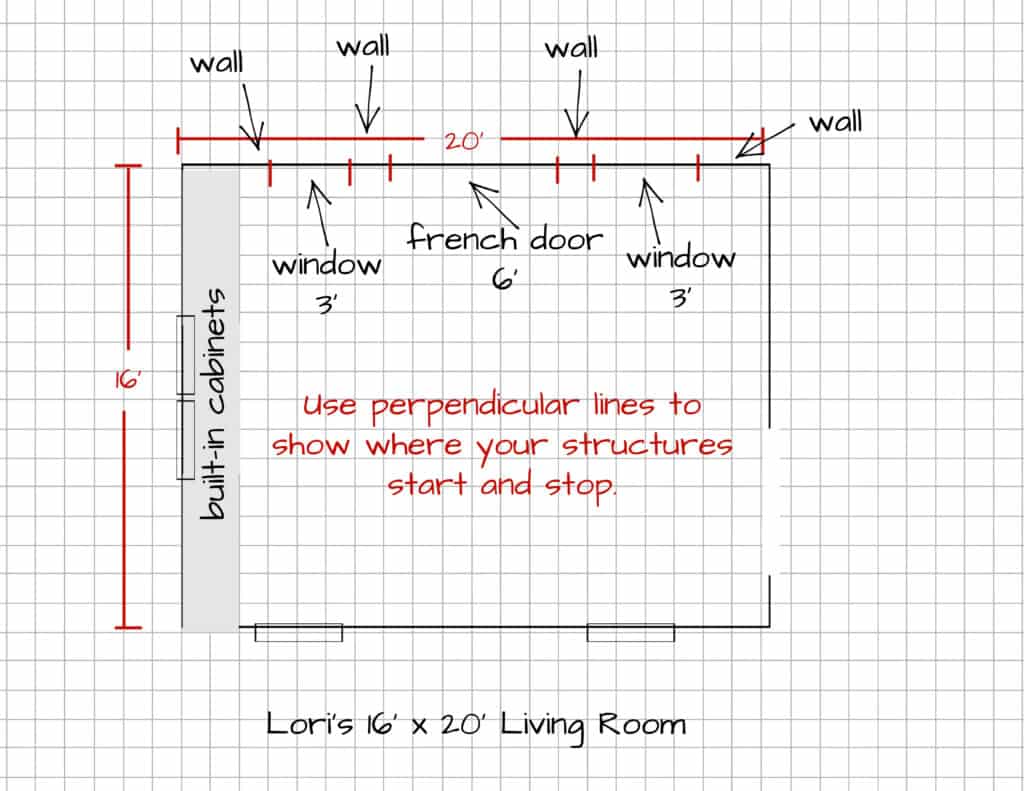
I have built-ins that go the whole length of one wall and stop just before the two side windows. I would draw them in the plan like the image below. You can see using the squares that my built-ins measure 2′ deep x 16′ long.

In the example below (bottom measurements starting from the right) I start off with a 2’8″ wall then the size of the windows measuring 3’1″ Then there is more wall space at 2’3″, then a window 3’1″, then wall 2’3″, then window 3’1″, a wall space at 9″ and finally my built-ins measuring 2′ deep. *I missed the 9″ measurement in the drawing sorry.
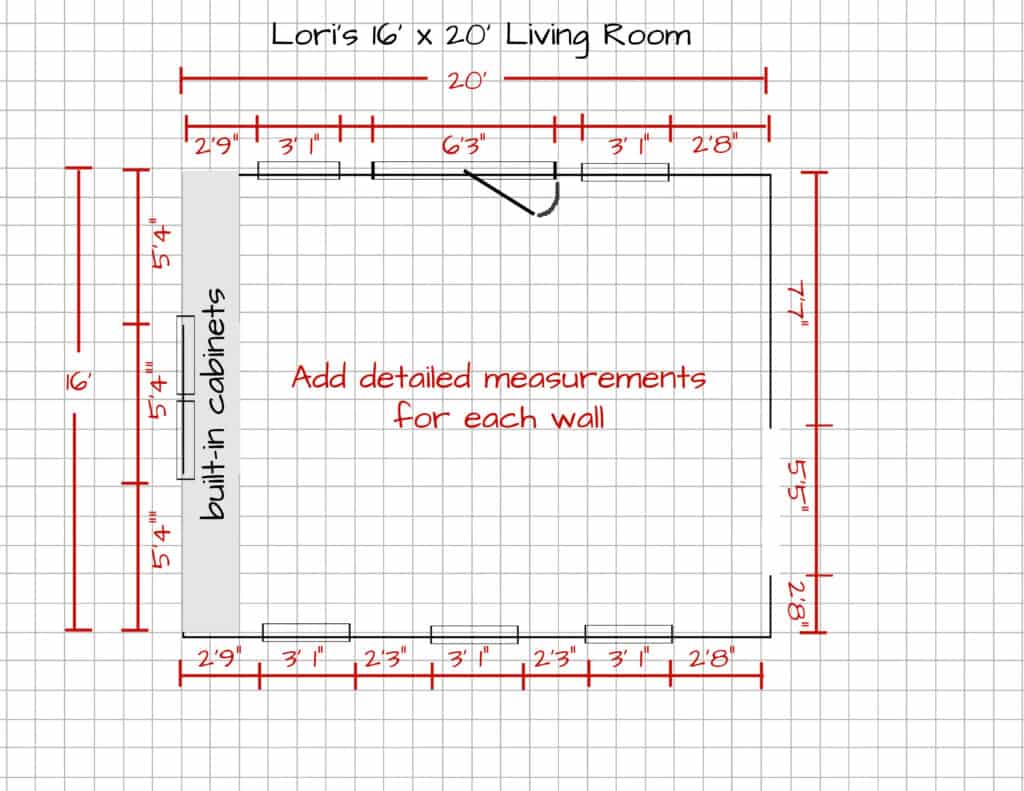
Hint:
If you add up all of those individual measurements they should total the whole length of the wall. If it doesn’t, re-check your measurements.
For furniture arranging it doesn’t have to be exact. An inch or two for a whole wall is fine. Your just using this to help you place furniture and an inch here or there isn’t going to ruin everything.
However, if you’re trying to squeeze something into a tight space, like kitchen cabinets that have to fit between two walls for an example, then you will need accurate measurements.
If that’s the case you may be better off having a professional draw a floor plan just to make sure you don’t run into any issues. It’s much safer to use scale floor plans for areas in your home such as a living room, dining room, or bedroom. But, as long as you are not dealing with cabinetry, appliances, or bath fixtures you should be just fine.

You might like this…
Are you thinking of redesigning your kitchen? I wrote a post titled “How to design your own kitchen layout plan” and it will teach you how to create the best kitchen layout for you and your family. Check it out!
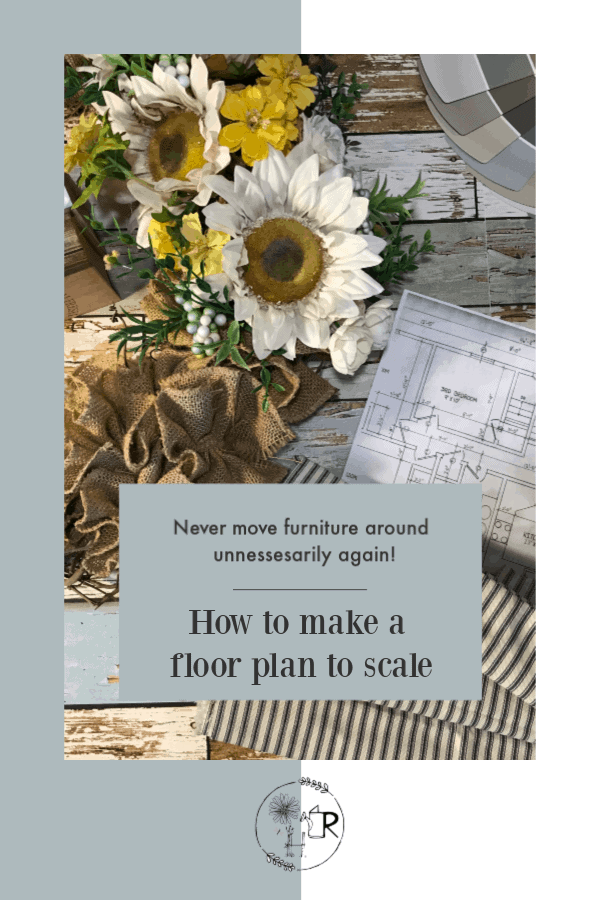
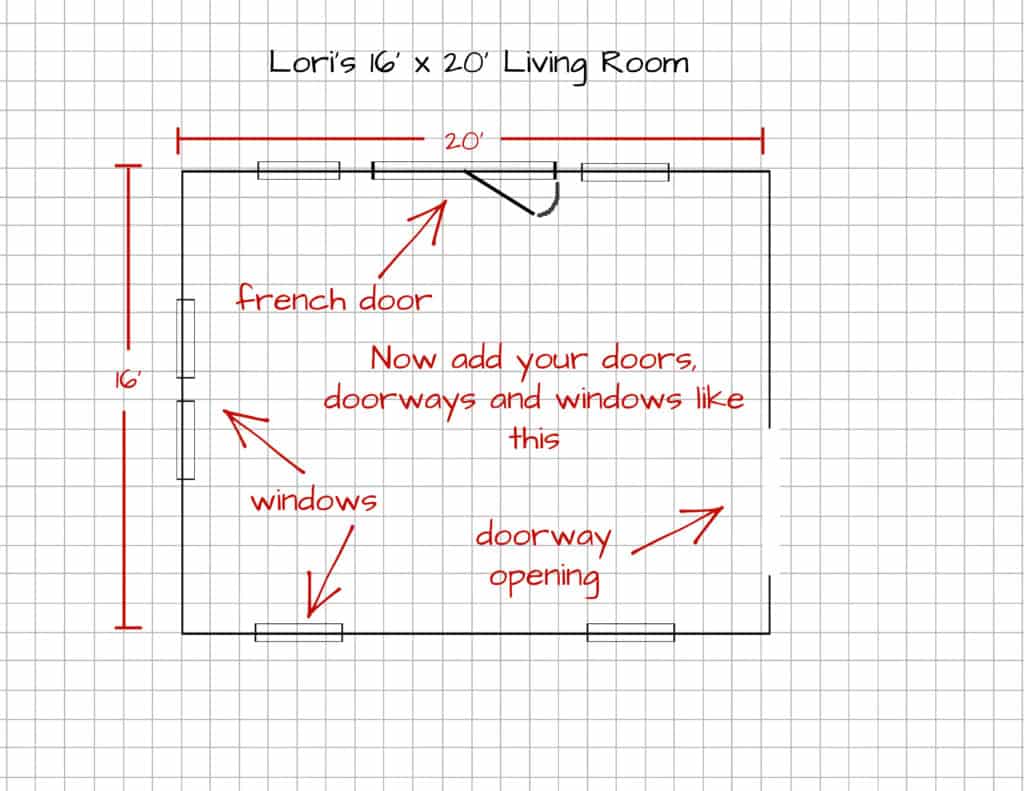
How to draw windows on a floor plan
If you have a window you can now make it look like a window by adding a line on the outside, and inside of the wall line to connect your perpendicular measurement marks. It kind of looks like a box with a line in the middle. See the red circle.

How to draw doors and door openings on a floor plan
If you are drawing a doorway or wall opening then mark the start and finish with perpendicular lines. Then erase the wall line in between to show the opening.
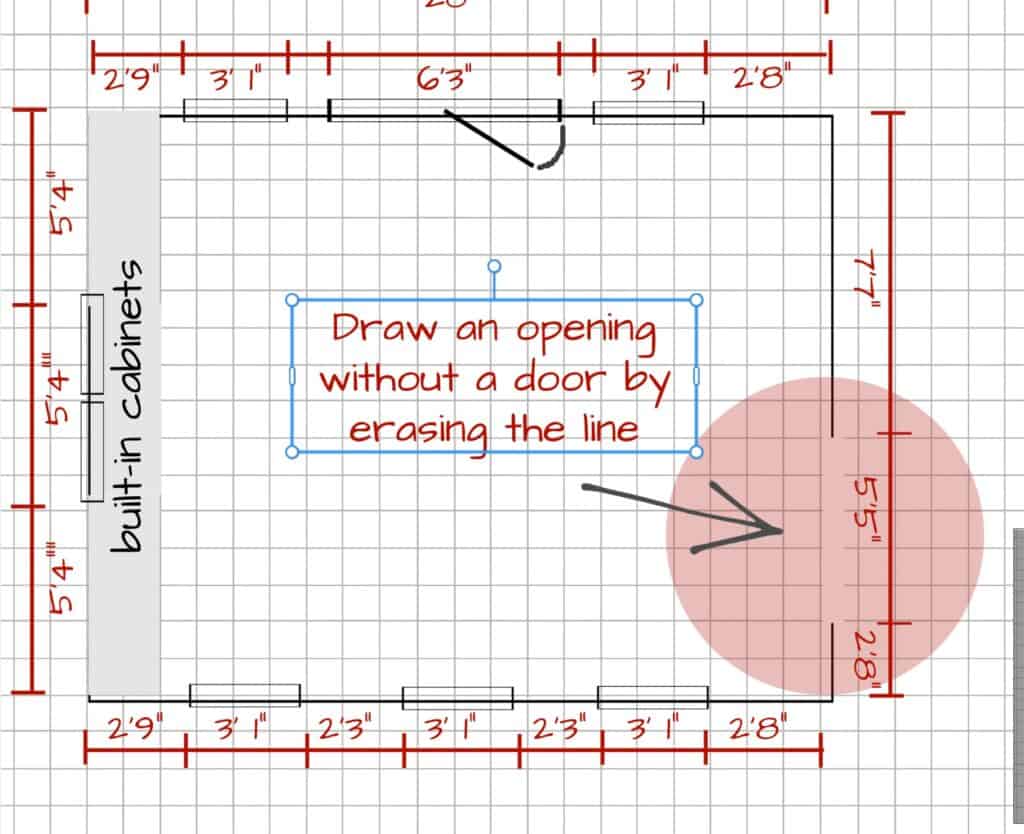
If you have an actual door on the doorway then you can show the swing of the door by adding a line and a curve. It is important to note the door swing on a plan. This way you know not to put a piece of furniture in the way of a door so it can open and close properly.
The example below is a drawing of my French doors that lead outside. That is why it looks like windows with a door swing. If it were a regular wood door I would show this on the plan by erasing the line in between the marks and then adding the door swing.
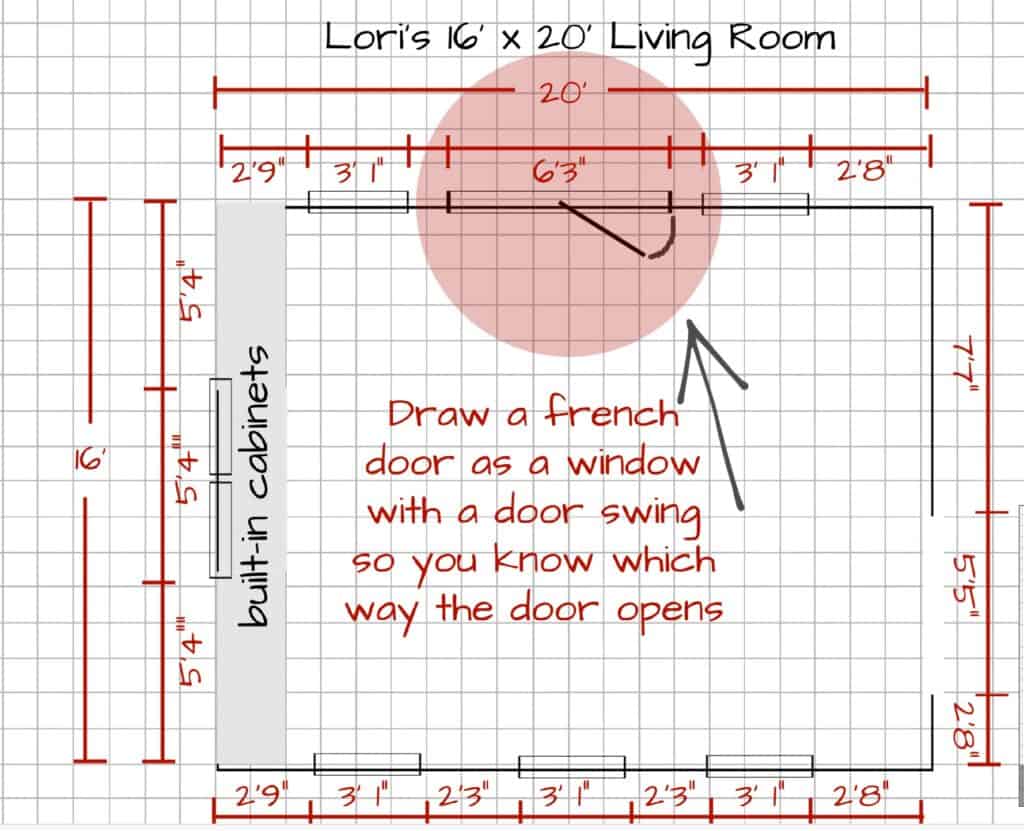
How to draw a fireplace on a floor plan
To mark a fireplace draw it like this example below. Of course your fireplace may look different from the shape of this one. It’s the measurements that are important and not necessarily the shape so don’t freak out about getting it perfect.
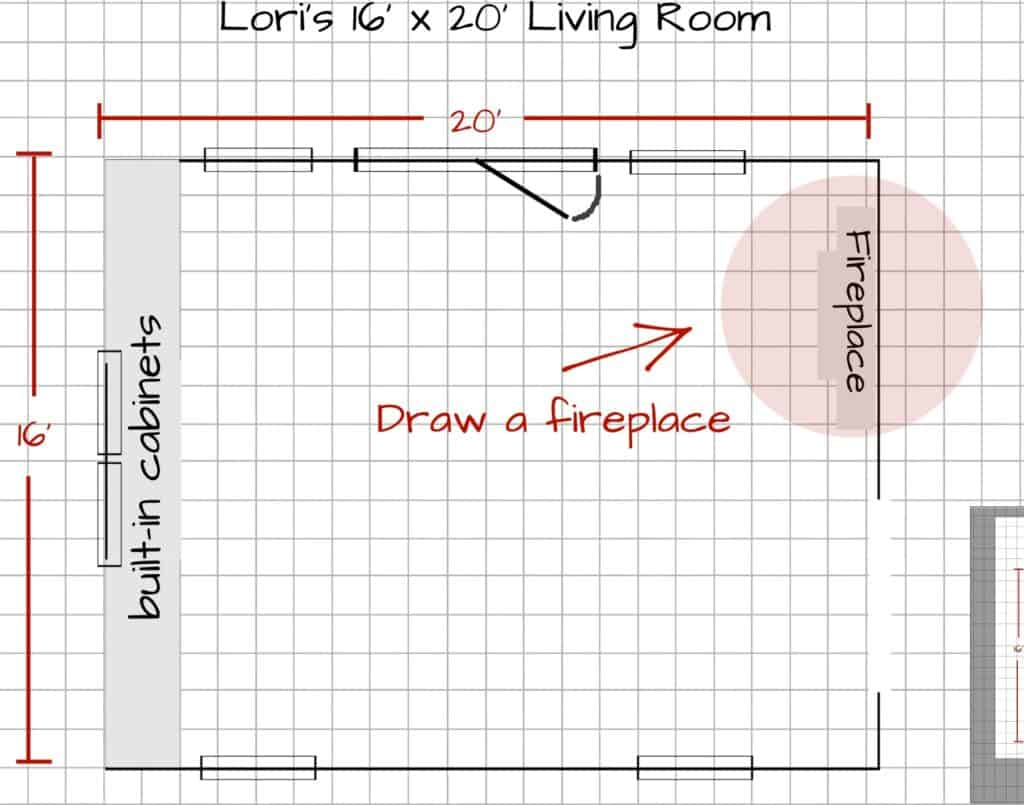
How to draw stairs on a floor plan
To show a staircase in a room you’ll just be drawing a rectangle the size of your stairs. You can also add the stairs by adding lines. Then you will add an arrow showing whether the stairs go up or down from that room.

Now that you have your room all measured and your floor plan drawing to scale, you are going to measure and draw all of your furniture pieces too. I will show you how to do this under the section, “measuring and scaling the contents of your room” below.
But, first I want to show you how to draw a floor plan with a plain piece of paper and a ruler. This is a link for an architectural ruler, which has the different scales right on the ruler. But, you can also do it with a regular ruler.
How to scale a floor plan with plain paper, a ruler, and a pencil.
The best thing to do if your just starting out is to use the graph paper method. But if you only have plain paper, it is still doable.
Starting with your hand drawn room, if you measured your room using inches, instead of feet and inches, you might want to convert that measurement to feet and inches first to make this step easier. See example below. 62.75″ = 5′ 3″

With your ruler your going to convert all your measurements from feet and inches, to inches and fractions of inches.
I know I just told you to convert to feet and inches. But this is different. Hang in there. It’s easier than it sounds.
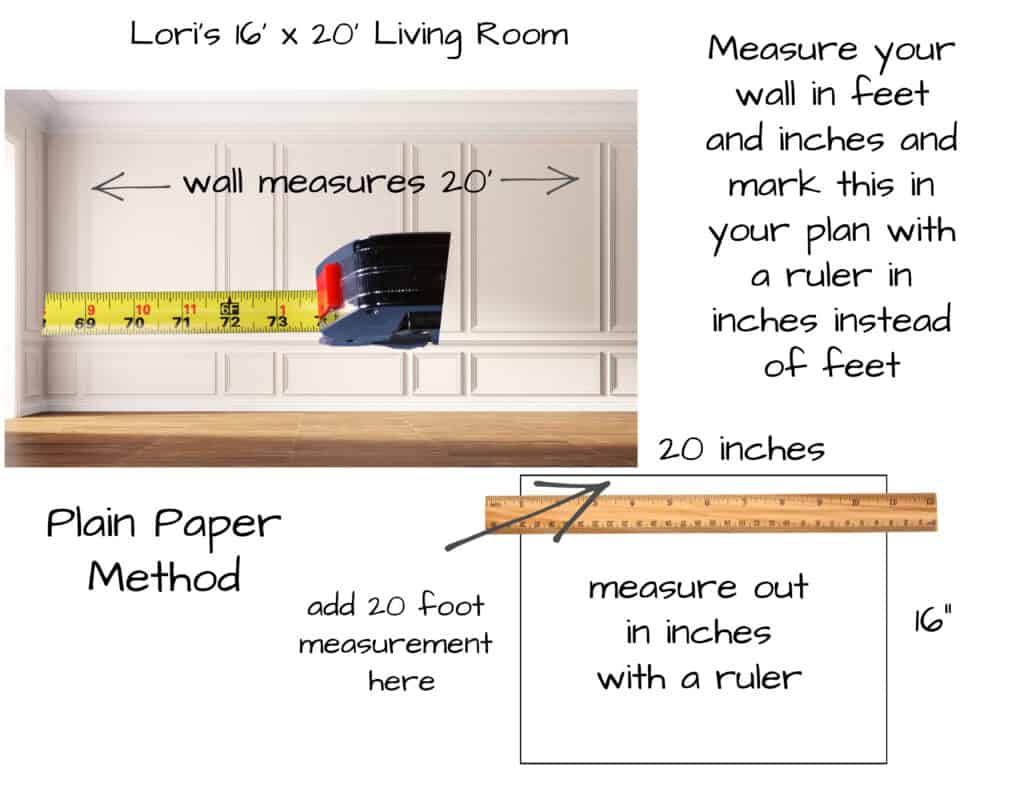
Here’s an example.
If your wall measured 12′ 6″ (twelve feet, six inches) then you’ll draw a straight line with your ruler that is 12.6″ (twelve and a half inches). Your converting the feet to inches, and the inches to fractions of inches. If you kept the measurement at 62.75 inches you wouldn’t be able to convert this correctly. Make sense?
Repeat this for all of your walls.
What’s happening is we are basically shrinking your room down so it will fit onto a piece of paper while keeping the scale of everything in it the same.
If your room is larger than 8′ (feet) x 11′ (feet) then you will need a larger piece of paper for this to work because your drawing will be bigger then an 8 1/2 x 11 piece of paper.
My room is 16′ x 20′ so I will need a larger piece of paper at least 16 inches by 20 inches. Actually more because I need room to write my measurements on the outsides of the walls.
Below is my initial scaled drawing showing the walls at 16′ and 20′.
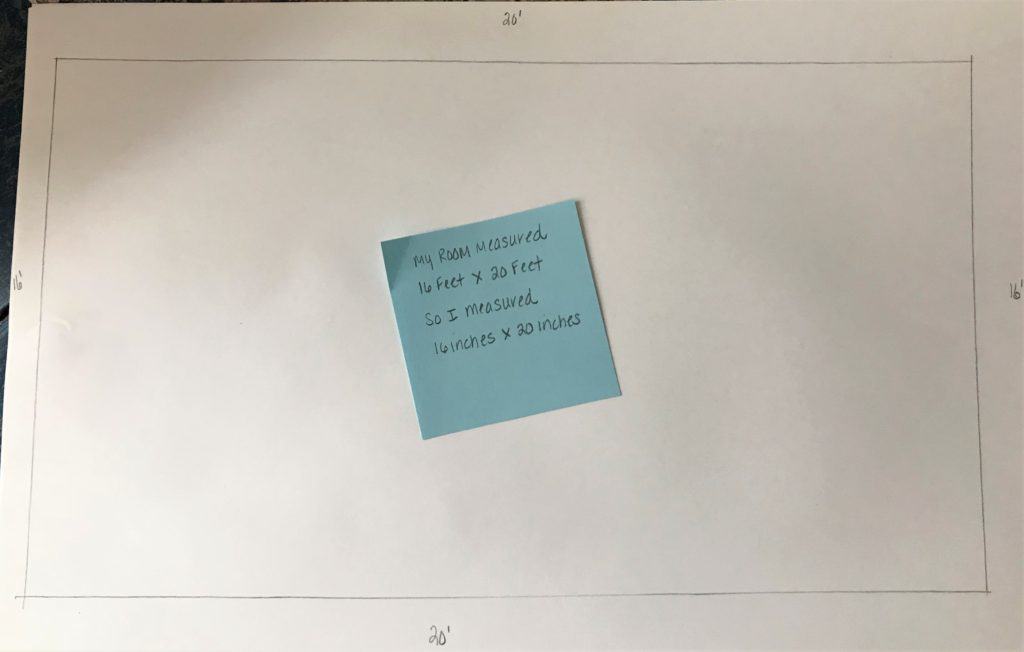
You can also use an architect’s scale ruler and it will do some of the work for you. Basically the ruler has different sides and each side has a different scale measurement.
So, if your drawing has a 1/4″ scale, you can just flip the ruler to the 1/4″ side of your ruler and mark your measurements.
How to transfer measurements from your hand drawing to a scaled drawing
Now you need to take the hand drawing with your doors, windows and permanent structures that you drew at the beginning of this lesson, and transfer them onto your new drawing.
Your basically taking the measurements from your hand drawing, changing them to inches, and marking them on your scaled plan with your ruler.
You are going to draw this the same way as the graph paper method but measuring and marking with a ruler on plain paper instead of counting squares.
Below you can see I measured some wall sections, a window, and a French door onto my first wall with lines. The ruler shows you how I changed my measurement on the French door from (six feet, three inches) the actual size of the door, to (six point three inches) our scaled measurement, and marked that measurement with perpendicular lines.
Do this for all of your measurements starting from the beginning of a wall to the end of the wall. Your still going to write the actual measurement on the plan. Your just changing the size of your drawing.
Do this with all of your walls, window, doors, and permenant structures.
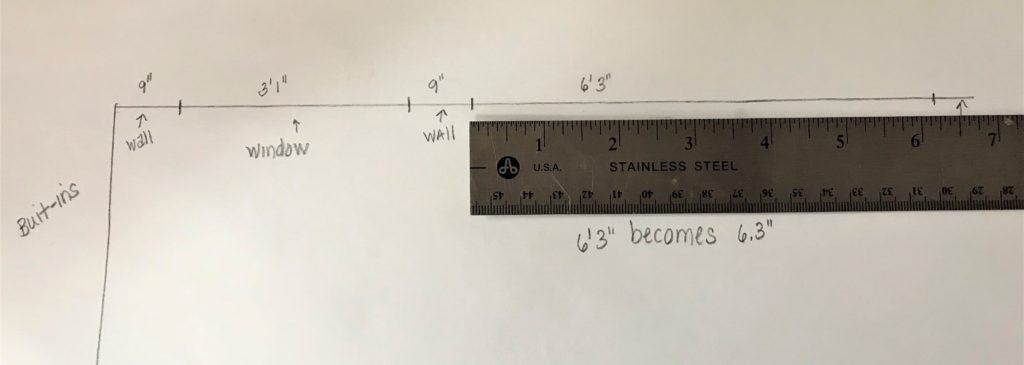
This is definitely harder than using the graph paper. But once you get the hang of it, it’s not so bad. I highly recommend starting with graph paper for the first time.
How to draw furniture to scale
How to scale and draw the contents of your room
Once you have the room all drawn out to scale you will now measure everything you are going to put into the room. Furniture, rugs, floor plants, floor lamps, etc.
If you are using existing furniture then just measure it the same way you measured the room and convert it to scale.
Example: If your sofa is 7′ long x 3′ deep, then your scaled sofa will be 7″ x 3″ for the plain paper method. Or 7 squares by 3 squares if you’re using the graph paper method.
If your purchasing new furniture then take the measurements and convert them the same way…before your buy it!
* Just remember…you must use one of the methods for both the room and the furniture.
If you used the plain paper method to draw your room, then draw your furniture with plain paper and a ruler.
If you drew your room with graph paper then draw your furniture with graph paper using the squares method. 1 sq = 1′ or 2 sq = 1′
And if you used your printer to enlarge your floor plan then use the same percentage to enlarge your furniture pieces after you draw them all on one sheet of paper.
Transfer your furniture measurements to the plan
Draw everything going into the room, with a ruler, on a separate piece of plain paper, or graph paper. Then label them.
Then you are going to cut out these pieces. They should look something like this example below. I’m showing you the graph paper version at 1 square per foot.
*Remember, if you drew your room with 2 squares per foot, then your furniture has to be at 2 squares per foot! If you don’t do this your whole scale will be off and your room design will be wrong.

Make sure to mark each piece so you know what it is. Don’t forget, if you enlarged the drawing of the room, you are going to want to enlarge this page the same way before you cut out the pieces.
Need help drawing those furniture pieces? Try using some floor plan templates. Keep the scale in mind when choosing your graph paper and templates. Make sure they are the same scale. The most common scales is 1/4″ = 1′. But there is also 1/2″ = 1′ and 1/8″ =1′ For our drawing scale will be 1/4″. This will be one square on a 1/4″ scaled piece of graph paper.
How to use your scaled floor plan
Now that you have your room to scale and your furniture pieces to scale you can move the furniture cutouts around in the room as much as you like until you find the perfect arrangement for your space.
Look for good traffic flow, make sure your furniture is addressing your focal point, and doesn’t block any doorways.

You might like this…
Want to learn more about traffic flow and focal points? Read my post “How to redesign a room, In one day, Without spending a dime”
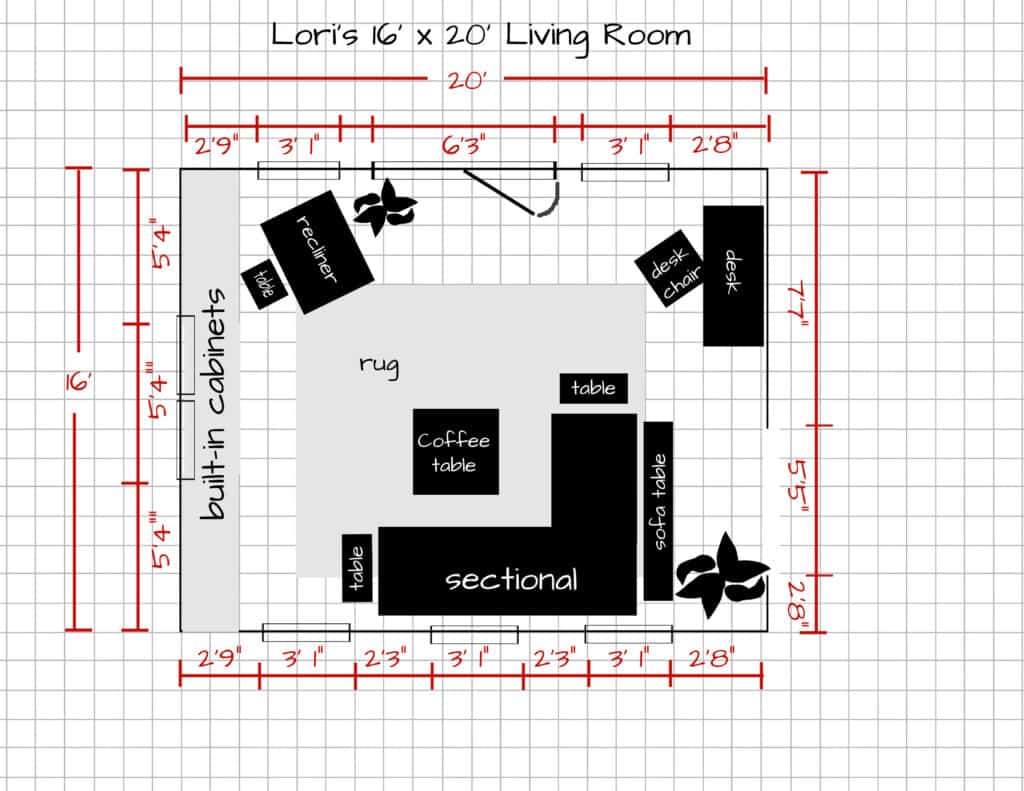
You can see exactly how all of your furniture will fit into the room by simply moving the furniture peices around on your floor plan.
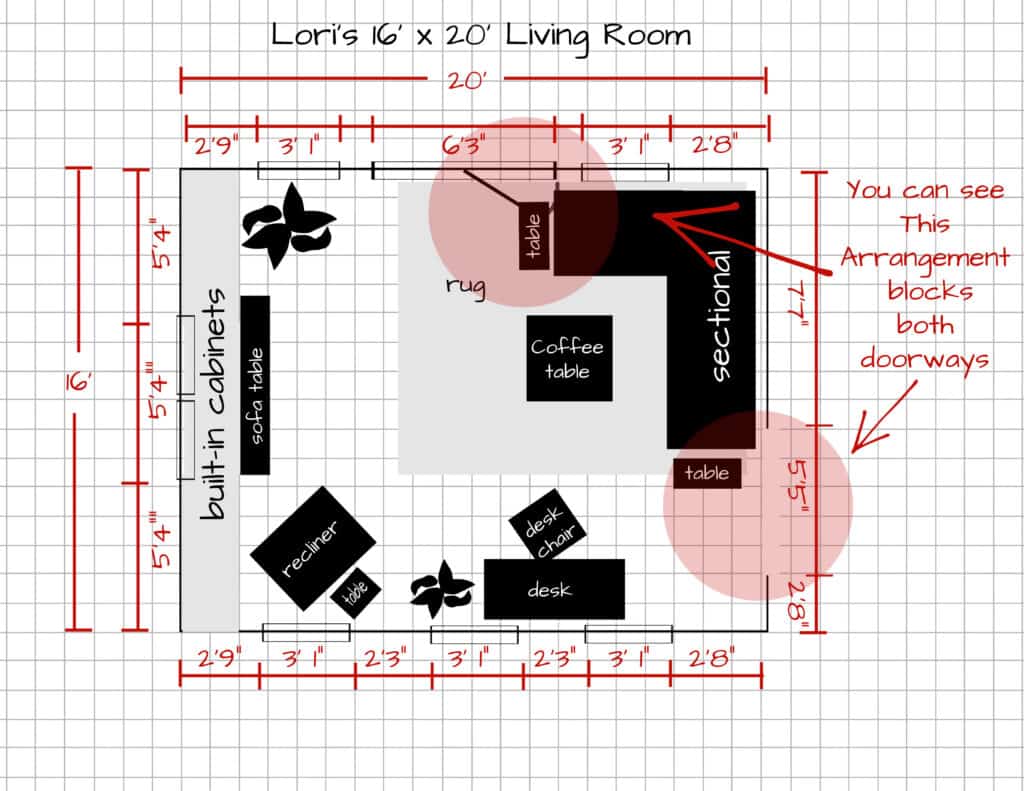
Notice in this second example that the furniture arrangement isn’t optimal. The sectional actually blocks part of the enterence to the room and blocks a little of the french doors. In just two seconds I can see where my furniture will, or will not, work.
Summary…
When you draw floor plans to scale it will save you so much time and frustration when decorating or shopping for your room. Keep your plan safe and the next time you get the decorating bug you can pull it out and play around with ideas to your hearts content.
If you decide you want learn how to draw a floor plan to scale online, try using a digital floor plan program. Room Sketcher is a good one to start with and it’s free.
If you have any questions or comments please feel free to post them below.
Related Posts…



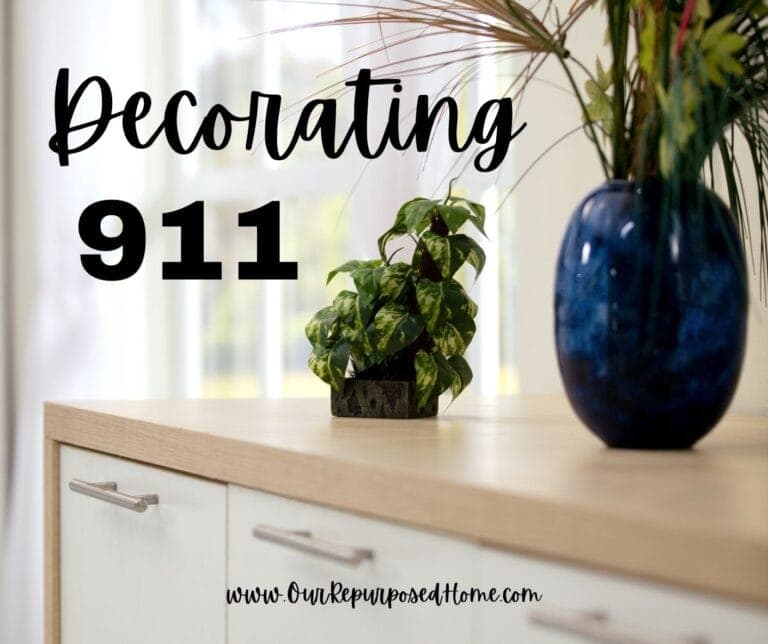

Hi there,
I appreciate your wonderful blog, which I have read from beginning to end.
I would appreciate it if you could share your emails with me or reach out to me at the gmail address listed below. I have some questions.
archdiyhouseplan@gmail.com
Thank you so much. I’ll email you.
Hello, I wanna say thank you for these steps but I had one question to ask.
How can I integrate building codes and universal design features into my floor plan?
Hi Sillabullah, Thank you for your inquiry. Integrating codes and universal design elements is much more advanced then this post is meant for. This post is for teaching people how to measure and draw a floor plan of their existing space, not design a space for a floor plan. I think what you are asking is “how can you use universal design elements to design your space?”
I just had to comment! U are truly a god-send. The steps, examples, explanations, etc helped me have confidence making a floor plan. I’m studying feng shui by the way. I’m so glad I found you on Pinterest.
-Blessings
Awe. Thank you so much. Glad I could help. Let me know if you need any help with your floor plans. 😊
I’ve noticed you work in inches ! Please can u change it to mm . I use it for my work am joiner so it needs to be in mm ta
Hi Mark, I am from the US so we use inches and not Metrics. However, you can easily make your drawing using MM. Just follow the directions for drawing the floor plan using plain paper and not the grid paper. You will simply use your metric system to convert meters to centimeters. I don’t know the metric system but I’m pretty sure it works the same as our system (feet and inches) vs (meters and centimeters). Let me know if this makes sense.
Hello, I’m not sure if this is a silly question, but does it matter which graph paper size you use? I see there are several options 1/4 inc, 1/2 inc, 1 inch paper. in the 8.5 x 11 paper. I’m working on a nursery and trying to figure out the scale before I actually move 2 cribs and lots of other furniture to another building. I think this would help my husband and I a lot before we do all the lifting. Thank you for your help and for posting this info. I wish I had read your post a long time ago, but I thank God for it now right before the move in the New Year.
Hi Linda, that was not a silly question. It doesn’t matter the size of your grid paper as long as you are making your furniture templates with the same scale.
Just count each square as a foot or 1/2 foot (whatever is easiest for you) and when you make your furniture pieces use the same size grid paper and same measurements per square. Then your scale will be the same.
Hope this helps,
Lori